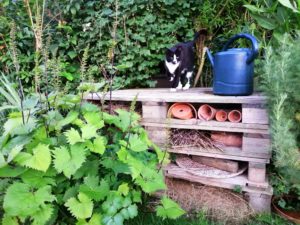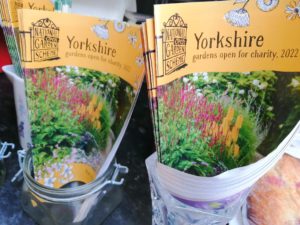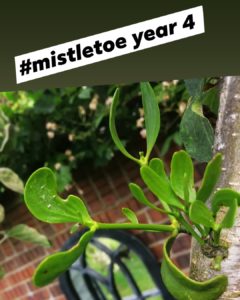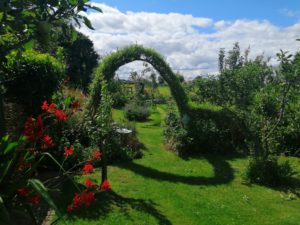This Week’s Guest Blogger is Justine Dixon who writes about her gardening life

Well finally I think we see light at the end of the covid tunnel what a couple of years we’ve all had but what as asset our gardens have been to those of us who are lucky enough to have them, but the local parks and outdoor spaces have been a blessing to others too.
All of our lives have been shaken up through Covid whether or not we’ve lost someone close or a neighbour, friend or a villager it affects us all and makes us look on life differently. But on a positive note, we battled on wearing facemasks, social distancing, lockdown and throughout all this our gardens and greenspaces were there for us.
A place to site, wander or potter I’ve been trialling & reviewing some peat free composts this springtime trying to persuade people peat free is the way to go!

I also opened my garden http://www.rosemarycottagehook.co.uk for the National Garden Scheme again following a 3-year break (should have opened 2021 but wasn’t comfortable in doing so) and it was a great success just under 300 visitors from far and wide it was so lovely to see familiar faces as well as intrigued new visitors who have just got into the open gardening visiting circle. Chatting about my garden, pointing out my 4-year mistletoe growing experiment, complementing me on my living willow arch and the way I garden with nature clover avenues in my lawns & supplement feeding hedgehogs throughout the year. My raised veg beds were a talking point too. People are so kind I love listening to the visitors chit chat whilst they wander around. http://www.ngs.org.uk

Gardening gets you thinking about the next growing season I’ve just placed my spring bulb order for Hook Gardening Club fundraising. Always very popular Spring Bulb & Cake stall I hold at the end of February but have to plant up all the pots of bulbs when they arrive in September, for this I use my folding potting bench aka old ironing board.
I’ve just started planning to restart Hook Gardening Club Meetings in January 2023 I’ve Horticultural Speakers to book, venue to confirm and rally together volunteers http://www.hookgardening.club We had big plans to celebrate our 10th anniversary in March 2020 (I had booked Chris Beardshaw 2 years ahead of our anniversary), but it all was cancelled with Covid…. So maybe we’ll celebrate our 15th anniversary in 2025 instead better start thinking of how we might like to celebrate #thinkingcapson.
So back to our gardens as I type this, we are experiencing extreme heatwave 30 degrees forecast today. I did venture out into my garden briefly this morning, but it was too hot so decided it was a day for writing gardening blogs and I also write a voluntary monthly gardening column for my local rag The Goole Times Newspaper http://www.gooletimes.info
My job has changed through the pandemic (following a 30 yr. professionally nannying career) I am now a parttime community minibus driver for The Goole Gofar http://www.Goolegofar.org.uk which offers a MEDiBUS door to door service to the elderly, disabled and those who would have difficulty getting to medical appointments. My weeks vary as they also have school bus contracts too and community shoppers. I love the variety each weeks brings and even get recognised whilst driving the bus ‘your Justine who writes the gardening column.

My other seasonal job is working at Mires Beck Nursery near North Cave http://www.miresbeck.co.uk as a retail plant sales assistant on weekends March – end September, I’m like a kid in a candy shop. Mires Beck has been a registered charity since 1994. They provide work experience and social therapeutic horticulture for adults who live with the challenges of learning difficulties, Autism and physical disabilities at their 14-acre nursery and conservation site. Exposed to the benefits of the natural rural environment on which the nursery sits, the work with our services users enriches lives with improvements in their physical and social abilities. Over the last 25 years we have grown to supporting 100 adults weekly through our adult day service and commercial enterprise and they are still growing.
So, my life has changed too but gardening is still very much in my heart and will always be.
Happy Gardening














